Intel Beast Canyon NUC Review: Desktop Tiger Lake Debuts in SFF Gaming Powerhouse
by Ganesh T S on July 29, 2021 9:00 AM EST- Posted in
- Systems
- Intel
- NUC
- Tiger Lake
- NUC11
- Beast Canyon
BAPCo SYSmark 25
The Intel NUC11BTMi9 (Beast Canyon) was evaluated using our Fall 2018 test suite for small-form factor PCs. In the first section, we will be looking at SYSmark 25.
BAPCo's SYSmark 25 is an application-based benchmark that uses real-world applications to replay usage patterns of business users in the areas of productivity, creativity, and responsiveness. The 'Productivity Scenario' covers office-centric activities including word processing, spreadsheet usage, financial analysis, software development, application installation, file compression, and e-mail management. The 'Creativity Scenario' represents media-centric activities such as digital photo processing, AI and ML for face recognition in photos and videos for the purpose of content creation, etc. The 'Responsiveness Scenario' evaluates the ability of the system to react in a quick manner to user inputs in areas such as application and file launches, web browsing, and multi-tasking.
Scores are meant to be compared against a reference desktop (the SYSmark 25 calibration system, a Lenovo Thinkcenter M720q with a Core i5-8500T and 8GB of DDR4 memory to go with a 256GB M.2 NVMe SSD). The calibration system scores 1000 in each of the scenarios. A score of, say, 2000, would imply that the system under test is twice as fast as the reference system.
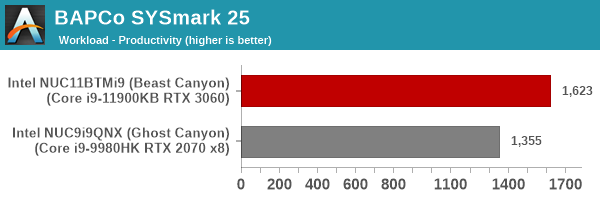
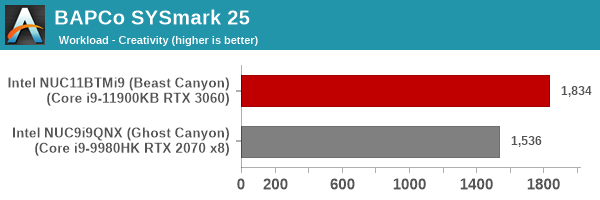
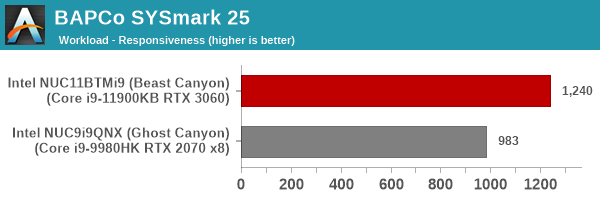
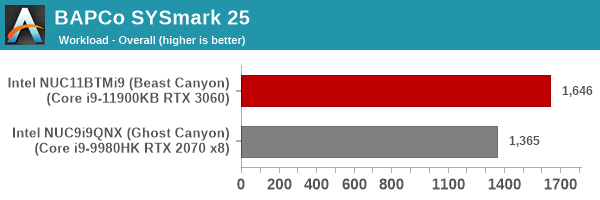
SYSmark 25 also adds energy measurement to the mix. A high score in the SYSmark benchmarks might be nice to have, but, potential customers also need to determine the balance between power consumption and the efficiency of the system. For example, in the average office scenario, it might not be worth purchasing a noisy and power-hungry PC just because it ends up with a 2000 score in the SYSmark 2014 SE benchmarks. In order to provide a balanced perspective, SYSmark 25 also allows vendors and decision makers to track the energy consumption during each workload. In the graphs below, we find the total energy consumed by the PC under test for a single iteration of each SYSmark 25 workload. For reference, the calibration system consumes 8.88 Wh for productivity, 10.81 Wh for creativity, and 19.69 Wh overall.
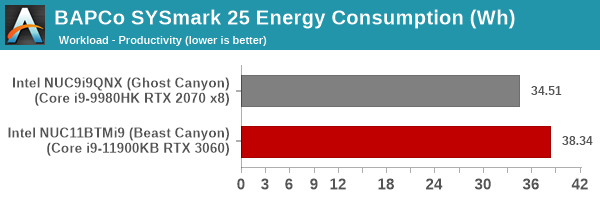
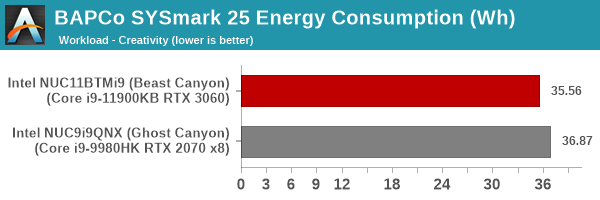
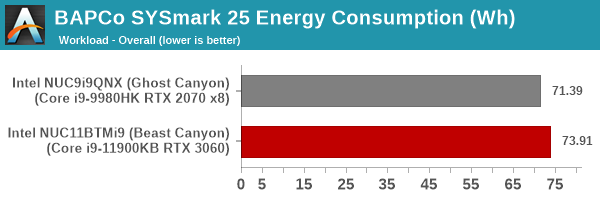
The Beast Canyon outscores the Ghost Canyon by around 20%. The increase in energy consumption is miniscule.










84 Comments
View All Comments
Spunjji - Friday, July 30, 2021 - link
"Can I buy the new compute element card and put it in a Ghost Canyon case?"I've been wondering that - I thought part of the point of the Element was to enable that sort of upgrade, but then I guess you'd lose the PCIe 4.0 compatibility
damianrobertjones - Friday, July 30, 2021 - link
Question: Can you purchase (I believe you can) JUST the element and place it into the previous model's chassis? That's what I was led to believe with this 'supposed' upgradability. If not, then possibly avoid this machine as there won't (probably) be an upgrade path. I did own the previous gen.Question 2: What the heck is going on with the smaller Nuc 11 units? I cannot seem to buy one ANYWHERE (u.k.).
mode_13h - Monday, August 2, 2021 - link
I think Tiger Lake is simply in high-demand. Intel likely prioritizes notebook OEMs above its own NUCs. Most NUC buyers probably don't know or care about the difference between 10th gen and 11th gen, so it's less bad to undersupply that market. Of course, this is all speculation.vol.2 - Tuesday, August 3, 2021 - link
I'm assuming they use the cheapest fans they can get away with. I'm sure the noise would improve dramatically if you replaced them with some better ones.Oxford Guy - Wednesday, August 11, 2021 - link
I’m sure the laws of physics are malleable.JoeDuarte - Tuesday, August 3, 2021 - link
1. It would help to benchmark them with more realistic specs, and consistent specs across the different SFF computers you included. 16 GB of RAM is too little for something this high-end, with an 8-core i9 Tiger Lake CPU, and a new-gen Nvidia 3060 GPU. (And you had 32 GB of in the Zotac...) 512 GB of SSD is too small for this kind of build, and there are big differences in SSD performance between 512 GB units and 1 TB+ sizes. (And you have different SSD models and sizes across the tested computers, ruining the validity of the results.)2. Intel's prices are still a bummer. I love the idea of a NUC, and of these X Canyon big-NUCs, but their prices and availability have always ruled them out. It's just worth it for what you get. We have to add several hundred dollars to that $1,350 price for this model. And hundreds more for a display, keyboard, and mouse. It's easily a $2,000 build, probably more like $2,300, all before taxes.
It makes more sense to go to PCPartPicker and build out a compact PC using one of those cuboid cases. They're a lot bigger than NUCs, but much smaller than mid-towers.
3. Intel really struggles with naming and model numbers. The NUCs are a messy jumble of letters and digits. And Intel commits the sin of having multiple names for the same thing, and you have to keep track of numerous confusing terms and their relation to each other. e.g.:
-- Goldmont vs. Apollo Lake, using Skylake arch, vs. Braxton vs. Willow Trail
-- Cherryview vs. Cherry Trail vs. Airmont
-- Beast Canyon vs. Bean Canyon vs. NUC vs. NUC11BTMi9
-- NUC11BTMi9 vs NUC11DBBi9, where the former is supposed to be a computer and the latter is a "Compute Element"
Nothing about the substring BTMi9 screams "computer", and nothing about the substring DBBi9 screams "Compute Element". It's all such a mess, and it makes it hard to shop for and buy Intel's products. If you don't already know the exact model number of what you want, there's no way to know from the model numbers that you encounter what you're getting or where it fits into the larger context of NUC models. These are things that any organization should be able to fix – clean, consistent naming, and clean, concise, and non-ugly model numbers.
mode_13h - Wednesday, August 4, 2021 - link
> It makes more sense to go to PCPartPicker and> build out a compact PC using one of those cuboid cases.
Except you cannot buy a Tiger Lake-H CPU. They're only sold in BGA and mostly found in laptops.
Unlike the Gemini/Jasper/Elkhart Lake CPUs (which are also BGA and often found in Chromebooks), you probably can't buy a mITX motherboard with them pre-installed, either.
JoeDuarte - Thursday, August 12, 2021 - link
I didn't think of that, though it wouldn't matter in my case. Whenever I build out a system at PCPartPicker I choose the Core i7-11700 or one of the Zen 3 chips – I think it's called a 5600 or 5800, but I forget. I don't think Tiger Lake-H would be an improvement from those, just maybe lower power.The GPUs are decent for integrated, and that has made me lean toward Intel because of the difficulty in finding current gen discrete GPUs like the 3060 Ti, but I haven't pulled the trigger yet. The Zen 3s don't have integrated GPUs, which would leave me without a GPU unless I settled for an obsolete 1650 or something. I'd rather live with the Intel 750 for a spell until the powerhouses are available at normal prices.
mode_13h - Friday, August 13, 2021 - link
> I choose the Core i7-11700 ... I don't think Tiger Lake-H would be an improvement> from those, just maybe lower power.
There are some notable differences. The desktop 11th gen CPUs are Rocket Lake, built on Intel's 14 nm++++ process, using Cypress Cove cores. Those cores are a 14 nm back-port of Ice Lake's (launched in 2019) Sunny Cove.
The Laptop & NUC 11th gen CPUs are Tiger Lake, which use Intel's 10 nm+++ node (also called 10 nm SF). They use Willow Cove cores, which are a generation newer than Ice Lake's (and therefore Rocket Lake's). However, the generational gains of the cores were modest, with the main difference being that Tiger Lake clocks higher.
Now, if you want to compare spec-for-spec, try this:
https://ark.intel.com/content/www/us/en/ark/compar...
The main thing that shows is that Tiger Lake-H has 50% more cache and the top-end model clocks lower. However, being a laptop chip, the top-end model also has a TDP of just 65 W. So, it's probably better to compare it with the fastest 65 W Rocket Lake:
https://ark.intel.com/content/www/us/en/ark/compar...
According to that, Tiger Lake-H is able to offer a much better Base clock, though its turbo is still lower. That's probably because its peak power is also lower, again being a laptop chip. Furthermore, clock speeds don't tell the whole story. In the end, specs are no match for actual benchmarks:
https://www.tomshardware.com/news/intels-enthusias...
These benchmarks show Rocket Lake pulling ahead in GPU tests, probably due to its faster turbo. However, when it comes to CPU-intensive tests, we see Tiger Lake hold its own.
Unfortunately, not many people seem to have run that exact comparison. Most are either comparing with the top Rocket Lake SKU or just other SFF PCs. If anyone else has benchmarks of the i9-11900KB vs. i9-11900, please share.
I guess the point is that if you care about power/noise/size, this NUC Extreme seems pretty compelling. If you're willing to spend a bit more and go for a top-of-the-line desktop, then you should probably fare better with Rocket Lake.
I wish Tiger Lake-H came in a LGA-1200 socketed version, so we could really see it stretch its legs. I'll bet it would beat even i9-11900KF by a noticeable amount.
> The Zen 3s don't have integrated GPUs
They do now! Check out the new Ryzen 5000G models!
https://www.anandtech.com/show/16824/amd-ryzen-7-5...
They're decent, for an integrated GPU, but not on par with the RTX 3060 in this NUC Extreme.
mode_13h - Wednesday, August 4, 2021 - link
> And Intel commits the sin of having multiple names for the same thing,> and you have to keep track of numerous confusing terms and their
> relation to each other. e.g.:
>
> -- Goldmont vs. Apollo Lake, using Skylake arch, vs. Braxton vs. Willow Trail
> -- Cherryview vs. Cherry Trail vs. Airmont
Goldmont is the core. Apollo Lake is the SoC. The "Mont" cores are the low-power ones. They've been very consistent about that: Silvermont, Airmont, Goldmont, Goldmont+, Tremont, and soon Gracemont.
Starting with Ice Lake, the big cores are named after coves, so far.
And the "Trail" names seem to be system designs, or something?
The one naming convention that really got out of control is the "lakes". Those seem to have very little consistent meaning. I think they have a few Lakes that aren't even CPUs/SoCs.
> Nothing about the substring BTMi9 screams "computer"
It's just a model number, dude. Just type it into a search engine and look it up. And some places I've seen will at least say it's a NUC compute element, although that requires you to know how one differs from a regular NUC.
> It's all such a mess
I will agree that Intel's product line is full of subtle variations, like NUCs with one vs. two Ethernet ports. I was staring at two Tiger Lake NUC listings, trying to figure out the difference, until I noticed that.